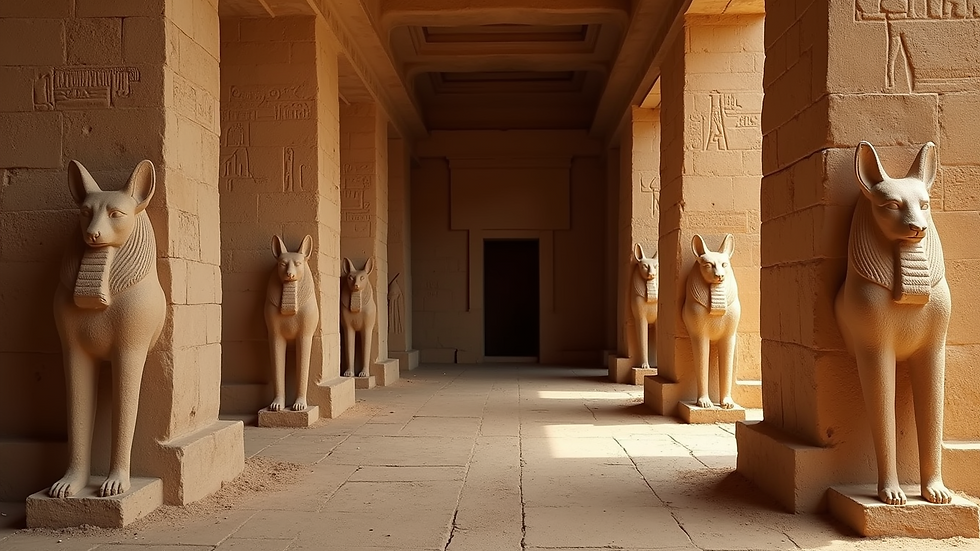Unveiling Anubis: The God of the Afterlife and His Role in Ancient Egyptian Mysticism
- Shy Johnson

- Sep 29
- 4 min read
Anubis, the enigmatic deity of Ancient Egypt, has captivated the imaginations of historians, archaeologists, and enthusiasts alike. Known primarily as the god of the afterlife, Anubis played a crucial role in the intricate tapestry of Egyptian mythology and religious practices. His striking jackal-headed figure symbolizes protection, guidance, and the transition from life to the afterlife. In this blog post, we will delve into the fascinating world of Anubis, exploring his origins, significance, and the rituals associated with him in Ancient Egyptian culture.
The Origins of Anubis
Anubis, whose name translates to "the royal child," has roots that trace back to the earliest periods of Ancient Egyptian history. Initially, he was associated with the funerary rites of the dead, serving as a protector of graves and a guide for souls navigating the afterlife. His image often appears in tomb paintings and artifacts, emphasizing his importance in the burial process.
The jackal, an animal commonly found in the deserts surrounding ancient cemeteries, became synonymous with Anubis. This connection likely arose from the jackal's scavenging behavior, which made it a natural guardian of the dead. Over time, Anubis evolved from a local deity to a central figure in the pantheon of Egyptian gods, embodying the complexities of death and rebirth.

Anubis in Egyptian Mythology
In the rich tapestry of Egyptian mythology, Anubis is often depicted as the son of Osiris and Nephthys. His role as a guide for souls is highlighted in the "Book of the Dead," a collection of spells and prayers designed to assist the deceased in their journey through the afterlife. Anubis is portrayed as the one who weighs the hearts of the dead against the feather of Ma'at, the goddess of truth and justice. This pivotal moment determines whether a soul is worthy of entering the afterlife or faces annihilation.
Anubis's dual nature as both a protector and a judge underscores the complexities of death in Ancient Egyptian belief. He is not merely a figure of fear; rather, he embodies the hope of safe passage and eternal life. This duality is reflected in the various titles attributed to him, such as "He Who is in the Place of Embalming" and "The One Who is in the Cemetery."
The Role of Anubis in Funerary Practices
Anubis's influence extended deeply into the funerary practices of Ancient Egypt. The process of mummification, essential for ensuring a successful afterlife, was often overseen by priests who invoked Anubis's name. The embalming rituals were designed to preserve the body, allowing the deceased to inhabit it in the afterlife. Anubis was believed to protect the body from decay and malevolent forces.
The iconic image of Anubis overseeing the mummification process is a powerful symbol of his protective nature. Tombs were adorned with depictions of Anubis, serving as a reminder of his watchful presence. The famous "Opening of the Mouth" ceremony, performed to animate the deceased, often featured Anubis as a central figure, emphasizing his role in the transition from life to death.

Anubis in Art and Iconography
The artistic representations of Anubis are as varied as they are captivating. From statues to wall paintings, his image has been immortalized in countless forms. The jackal-headed figure is often depicted in a black color, symbolizing fertility and rebirth, which contrasts with the white of the mummies. This color symbolism reflects the duality of life and death, a central theme in Ancient Egyptian culture.
Anubis's iconography also includes various symbols associated with the afterlife, such as the ankh (the symbol of life) and the sistrum (a musical instrument used in rituals). These elements highlight his integral role in the spiritual journey of the deceased, reinforcing the belief that death is not an end but a transition to another realm.
The Legacy of Anubis
The legacy of Anubis extends beyond the confines of Ancient Egypt. His image and symbolism have permeated popular culture, appearing in literature, film, and art. The fascination with Anubis continues to inspire modern interpretations of ancient myths, showcasing the enduring impact of this enigmatic deity.
In contemporary discussions about death and the afterlife, Anubis serves as a reminder of the rich spiritual traditions that have shaped human understanding of mortality. His role as a guide and protector resonates with those seeking comfort in the face of loss, bridging the gap between ancient beliefs and modern perspectives.
Conclusion
Anubis, the god of the afterlife, remains a captivating figure in the annals of Ancient Egyptian history. His multifaceted role as a protector, guide, and judge reflects the complexities of life, death, and rebirth. Through his enduring legacy, Anubis continues to inspire curiosity and reverence, inviting us to explore the mysteries of the afterlife and the rich tapestry of ancient beliefs.
As we unveil the layers of Anubis's significance, we gain a deeper appreciation for the intricate beliefs that shaped the lives of the Ancient Egyptians. Whether through the rituals of mummification or the artistic representations that adorn their tombs, Anubis stands as a testament to the enduring human quest for understanding and connection in the face of mortality.



Comments